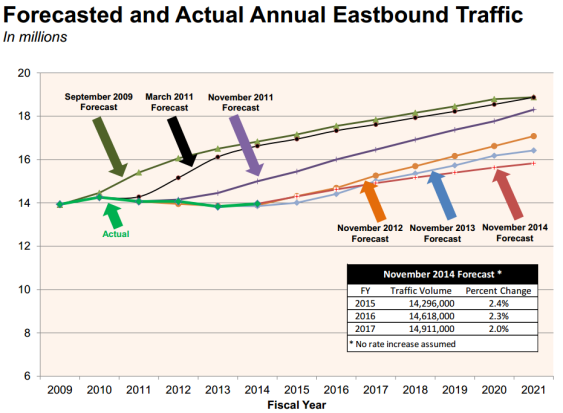The Kitsap Sun is reporting that a $1 per car toll increase on the Tacoma Narrows Bridge west of Tacoma, Washington is “close to a done deal.”
On July 1, rates will rise to $5 for Good To Go! electronic payment, $6 at the toll booths and $7 for pay-by-mail. A déjà vu will occur one year later.
WSDOT believes that if tolls on the bridge don’t rise, there’s a good chance that the state won’t have enough tolling revenue to cover the financing costs for the $728 million second span, which was opened to the public in 2007. Tolling shortfalls, in turn, could force WSDOT to dip into general transportation funds for a project that was supposed to pay for itself.
As the chart below shows, traffic across the bridge has consistently failed keep up with the forecasts. Traffic has been basically flat: despite a modest uptick in 2014, actual traffic volumes (the thick green line) are still about the same today as in 2009.

Yet the agency’s current “best” guess (the red line) remains remarkably similar to the one they made back in 2009: despite all evidence to the contrary, they assume traffic will soon begin a steady ascent. They’re counting on it, in fact, because without steady growth, bridge tolls might not bring enough revenue enough to pay back the bridge’s financing costs.
In short, the agency seems to view the modest traffic uptick in 2014 as the “new normal,” rather than as a short-term boost caused by low gas prices. Indeed, the monthly data shows that traffic was flat through the middle of 2014: it was only when gas prices fell in earnest that year-over-year traffic volumes started to rise in earnest. Still, WSDOT seems to view a few months’ worth of data as evidence that endless traffic growth is here to stay.
Yet to my eyes, WSDOT’s rosy traffic forecasts ignore the impact of higher tolls. The toll increase is steep: 22 percent over 2 years, reaching $5.50 for every round trip across the bridge. And if history is any guide, a toll increase of this magnitude is likely to suppress traffic growth.
In short, it’s possible that higher tolls will keep the Tacoma Narrows bridge stuck in the “tolling death-spiral,” where higher tolls suppress traffic growth, causing tolling revenue shortfalls, which in turn necessitate even higher tolls to raise enough money to cover debt payments. And if the bridge does wind up trapped in that vicious circle, the real culprit will be the traffic forecasters—the ones who based the financial plans for the bridge on optimistic but deeply flawed projections of endless traffic growth.


Comments are closed.